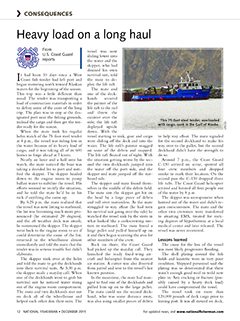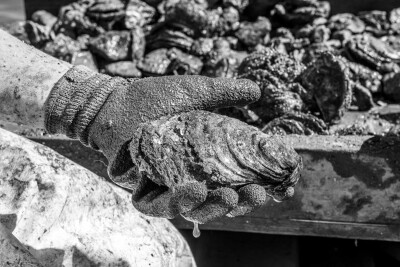Heavy load on a long haul
From U.S. Coast Guard reports
It had been 10 days since a West Coast fish tender had left port and began motoring north toward Alaskan waters for the beginning of the season. This trip was a little different than usual: The tender was transporting a load of construction materials in order to defray some of the costs of the long trip. The plan was to stop at the designated port near the fishing grounds, unload the cargo and then get the tender ready for the season.
When the mate took his regular helm watch of the 75-foot steel tender at 4 p.m., the vessel was riding low in the water because of its heavy load of cargo, and it was taking all of its 600 horses to forge ahead at 7 knots.
Nearly an hour and a half into his watch, the mate noticed the boat was taking a decided list to port and notified the skipper. The skipper headed down to the engine room to pump ballast water to stabilize the vessel. His efforts seemed to rectify the situation, and he told the mate he’d be in his rack if anything else came up.
By 5:25 p.m. the mate realized that the vessel was now listing to starboard, the list was becoming much more pronounced (he estimated 20 degrees), and the aft weather deck was awash; he summoned the skipper. The skipper went back to the engine room to see if could determine the cause of the list, returned to the wheelhouse almost immediately and told the mate that the tender was in serious trouble but didn’t elaborate.
The skipper took over at the helm and told the mate to get the deckhands into their survival suits. At 5:30 p.m. the skipper made a mayday call. When one of the deckhands went to grab his survival suit he noticed water rising out of the engine room compartment. The mate and two deckhands met out on deck aft of the wheelhouse and helped each other don their suits. The vessel was now sliding lower into the water and the skipper, who had donned his own survival suit, told the mate to deploy the life raft.
The mate and one of the deckhands secured the painter of the life raft to the rail and threw the canister over the side; the life raft deployed upside down. With the vessel starting to sink, gear and cargo were sliding off the deck and into the water. The life raft’s painter snagged on some of the debris and snapped. The life raft floated out of sight. With the situation getting worse by the second the two deckhands jumped into the water off the port side, and the skipper and mate jumped off the starboard side.
The skipper and mate found themselves in the middle of the debris field. The mate saw the skipper get hit on the head by a large piece of debris and roll over motionless. As the mate struggled to stay afloat (he had torn his survival suit going over the side) he watched the vessel sink by the stern in what looked like a corkscrewing motion to starboard. The mate found a large pallet and pulled himself up on it and then began scanning the area for other members of the crew.
Back on shore, the Coast Guard had picked up the mayday call. They launched the ready fixed-wing aircraft and helicopter from the nearest air station. A cutter was also diverted from patrol and sent to the vessel’s last known position.
In the meantime, the mate had managed to find one of the deckhands and pulled him up on to the large pallet. The mate could see the second deckhand, who was some distance away, was also using smaller pieces of debris to help stay afloat. The mate signaled for the second deckhand to make his way over to the pallet, but the second deckhand didn’t have the strength to do so.
Around 7 p.m., the Coast Guard C-130 arrived on scene, spotted all four crew members and dropped smoke to mark their location. On the second pass the C-130 dropped three life rafts. The Coast Guard helicopter arrived and hoisted all four people out of the water by 8 p.m.
The skipper was unresponsive when hoisted out of the water and didn’t regain consciousness. The mate and the other two crewmen were transferred to awaiting EMS, treated for varying degrees of hypothermia at a local medical center and later released. The vessel was never recovered.
Lessons learned
The cause for the loss of the vessel was most likely progressive flooding.
The shell plating around the fish holds and lazarette were in very poor condition. Shipyard personnel said the plating was so deteriorated that there wasn’t enough good steel to weld new plate to. Any cracking or fracture (possibly caused by a heavy deck load) could have compromised the vessel.
The vessel took on more than 120,000 pounds of deck cargo prior to leaving port. It was all stowed on deck, and there was no loading plan; it was stowed wherever there was open space aft. The vessel had minimal freeboard. To help alleviate the lack of freeboard, the skipper reduced the amount of ballast water from the usual 3,000 gallons to 500 gallons. The pumping out of ballast did not remedy the freeboard issue, but actually raised the vessel’s center of gravity, making it more top heavy and unstable.
Having enough freeboard is essential for stability. If the deck edge goes under the water when the vessel heels, the danger of downflooding and capsizing increases. An overloaded vessel will have too little freeboard. The deck will submerge with even a slight heel and low freeboard can allow for more water on deck. Water on deck creates a large free surface effect and also adds weight high in the vessel, which effects stability. Overloading is a major cause of fishing vessels’ downflooding and capsizing.
Inspect your boat’s hull regularly for damage or wastage. Check the interior to ensure that there is no daylight. Have accessible seacocks that are easy to close, and exercise them regularly so they do not seize up. If your vessel is watertight, you’ll have a better chance to fish safe!
This article is based on U.S. Coast Guard reporting and is intended to bring safety issues to the attention of our readers. It is not intended to judge or reach conclusions regarding the ability or capacity of any person, living or dead, or any boat or piece of equipment.








